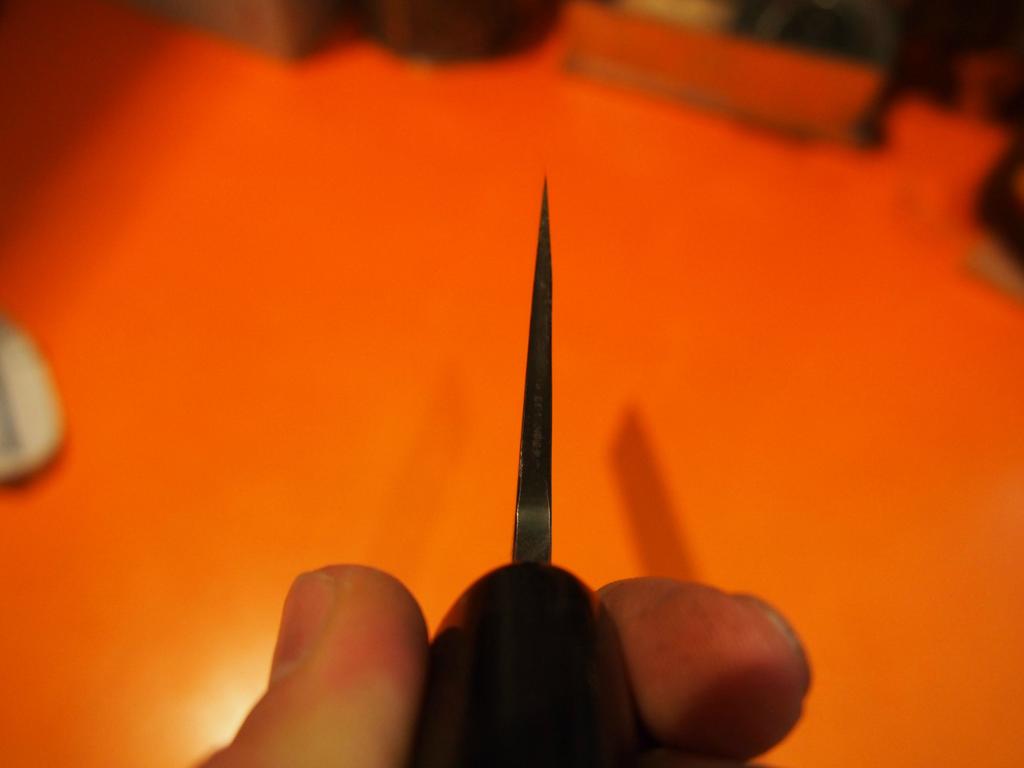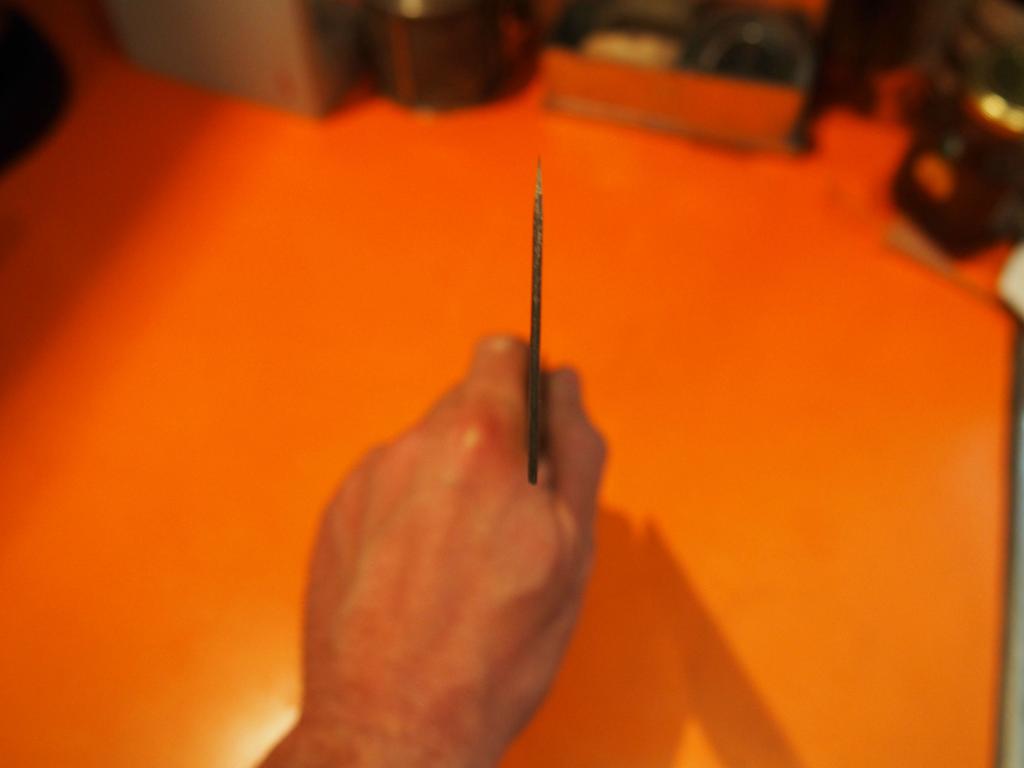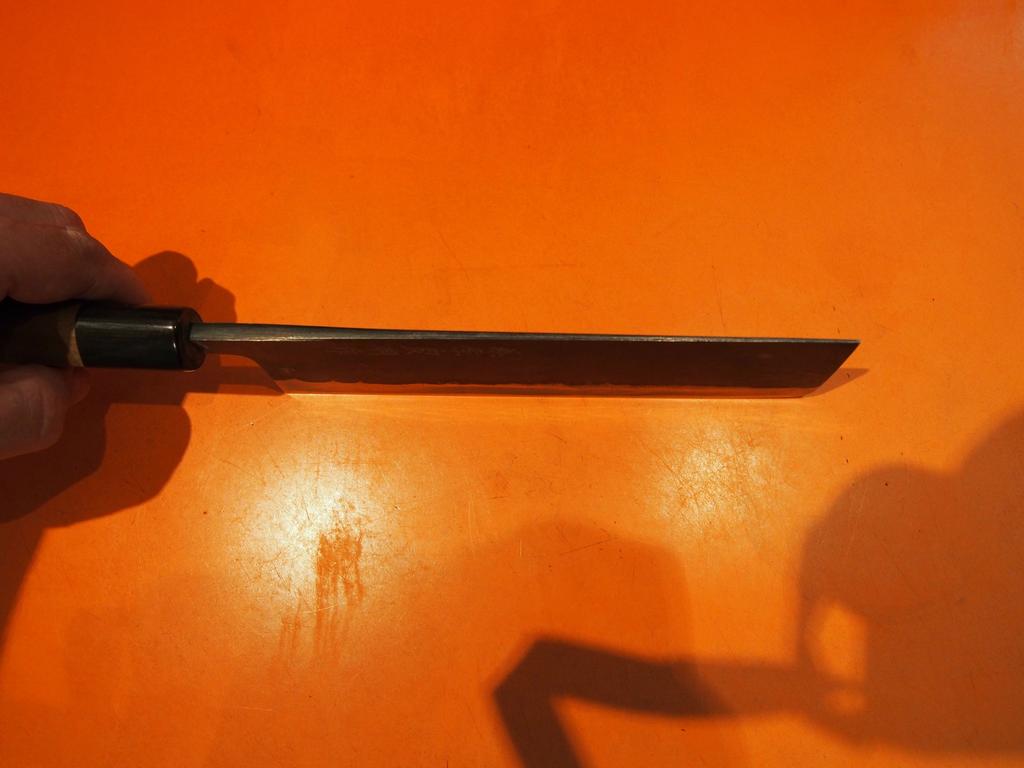JCHine,
Wonderful pictures! Initial impressions: behind the edge is more of an inverted V grind rather than the inverted Y, left side looks convexed (lefty bias) but hardly sure, and the overhead perspective of the spine is a wow! Best of both worlds in this grind. Good on densities of product all the way to a pumpkin? Would you use it to slice a butternut squash in half? That particular product, for me, requires regressing to my cutco butcher knife along with a wooden mallet. Again, thanks for the photos. It's nice to have a comparison from a nakiri user that implicitly says..."here's mine and I like it."
The more I lean into this nakiri project the more I'm amazed at the complexity and significance of what I took for granted. When I buy from a respected seller, whether it be TF or a domestic vendor that carries high price j.knives, I am disappointed to learn that I need to mitigate issues of a chunky and wavy grind. Tweaking is one thing yet in the case of either the lower end Yamashin or the relatively higher end TF, this is a full throttle endeavor. The upside is that both of these brands reveal very impressive white steel that to a rookie j.knife enthusiast have an eye popping toothy quality. The first micro millimeter into product has high performance value. After that point, this is where more intervention in needed than I expected.
I finished what is a third bevel setting session with the TF Nakiri. This time I went back to a more aggressive stone...Shapton Pro 220. I made what felt like major progress yet there's no way that behind the edge can be regarded as laser thin. I'm not sure that it's going to ever be in the category of an inverted Y. Like. JCHine's nakiri, the TF one of mine seems destined to be the inverted V. I'm not sure if these are established categories; rather, it is my best effort to wrap my head around what I'm doing. The Yamashin, just after one session, in contrast, I think can be the inverted Y even though it has a very thick grind. As a forum member pointed out to me, stainless steel clad on the TF is tough stuff to grind through. Indeed it is!!!! It was a lot more fun to (attempt to) sculpture the full carbon blade of the Yamashin rather than the TF. Could be that it would have been better to have something more aggressive like a belt sander or a diamond plate.
Another plus of the Yamashin is that the face of the blade stays smooth rather than scratched and bruised. Visually more appealing and less drag on product. I'm not pleased at all with the current condition of the face of the TF. I tried polishing it with slurry from two different slurry stones...one is the beglium coti and the other is white 400 grit nagura. Showed promise and maybe I just need the proper technique. Next step will be to use sandpaper. I need to purchase some of those fine and finer grit 3m sponges. Sand paper application will extend to the more usual areas of the choil and spine. Shamefully rough.
An open question is whether or not the TF nakiri has a wave or two in its grind. While ultimately manageable, I think that it does. The work from the SP 220 suggests this. I know that I started with a flat stone, yet the more that I ground on either side there was black (sharpie) that did not go away. I assume that these areas represents troughs. Only after a lot, and I mean a lot, of strokes on the 220 did the steel shine without the black residue. Slowly, I'm changing the geometry. For the better, I hope. Kind of flying bind.
Another area that will require more work is the toe and heal of the cutting edges. My eyes and fingers tell me that it's still too rough. This is an issue of technique..i.e., more to learn.
This morning I had an opportunity to put both nakiris to work. Each week I mince up about 10 quarts of produce..onions, bok choy, bell peppers, and radishes.
The TF did wedge in the onion--when cutting it in half. Does any other nakiri just fall through? Most onions are fairly tight/dense as opposed to apples where
some are very soft in the middle. The night before the same nakiri did just fall through a soft apple. On a large bell pepper, the stem stopped the TF nakiri cold. Rather than
force it, I replaced it with the TF 210 gytuo. Smooth as silk cut. Baffling. The Yamashin was Ok. A different experience since it's heavier. My hand, though, unconsciously
found that it wanted to go back to the TF.
Numbers from the caliper suggest that I went in the right direction in terms of achieving some consistency in thickness. Perhaps, I'm being overly optimistic.
If so, please feel free to say so. From heel to toe the measures that follow have a range of about 1mm or +/-.05mm. Is this reasonable or a little too forgiving?
2.5 mm up from the cutting edge: .55mm
5.0 mm up from the cutting edge: .80mm
Choil shots:
TF 210 choil for comparisn:
Problem with black sharpie removal:
Finished face appearance...still needs polishing






















